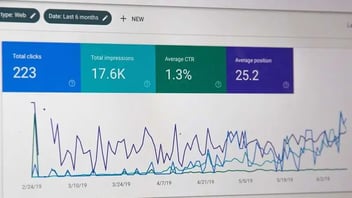DoFollow and NoFollow - What are Those Links, and When Do I Use Them?
If you're working to increase the online visibility of your business, understanding the nuances of DoFollow and NoFollow links is essential. These seemingly subtle attributes wield substantial power, impacting your website's visibility and credibility in digital marketing.

Regarding search engine optimization (SEO), DoFollow and NoFollow links are fundamental components that wield considerable influence over your website's visibility and authority in search engine results pages (SERPs). Understanding these link attributes is paramount for any digital marketer or website owner.
DoFollow Links
DoFollow links are like the highways of the internet. When a website links to another using a DoFollow attribute, it essentially endorses the linked page, passing on some of its own "link juice." Link juice is a metaphorical term for the SEO value and authority of a website. In simpler terms, DoFollow links can boost your website's organic search rankings by indicating to search engines that others trust and vouch for your content.
These links are valuable in SEO because they contribute positively to your website's backlink profile. The more high-quality DoFollow links you acquire from reputable websites in your niche, the better your chances of ranking higher in search results.
DoFollow links make up about 60% of all links on the web.
Imagine you run a travel blog, and a highly reputable travel website, "Wanderlust.com," mentions one of your articles in their blog post about "Top Destinations in 2023." They include a DoFollow link to your article within their content. In this scenario:
-
"Wanderlust.com" is endorsing your content by linking to it with a DoFollow attribute.
-
This DoFollow link passes on some of the SEO authority and trust that "Wanderlust.com" has earned for your website.
-
As a result, search engines like Google view your content as more credible and relevant, potentially boosting your article's ranking for relevant keywords like "Top Destinations in 2023."
When to Use DoFollow Links
DoFollow links are pivotal in enhancing your website's SEO performance, but knowing when and how to use them effectively is critical to reaping their benefits.
Quality and Relevance
The most critical factor when deciding to use DoFollow links is the quality and relevance of the linking source. You should prioritize obtaining DoFollow links from reputable and authoritative websites in your industry or niche. These links act as valuable endorsements, signaling to search engines that your content is trustworthy and worth ranking higher in search results.
Editorial Backlinks
DoFollow links from editorial content are gold in the world of SEO. These links typically come from within the body of a well-written article, blog post, or news piece. When a respected source editorially links to your content, it's a strong indicator of your website's authority and relevance, contributing positively to your search engine rankings.
Guest Posting
Guest posting on authoritative websites within your niche is an effective strategy for acquiring DoFollow links. You can earn these valuable endorsements by providing high-quality, informative content while establishing yourself as an industry expert.
Natural Citations
If your content is genuinely valuable and informative, other websites and bloggers may naturally reference and link to it. These organic DoFollow links testify to your content's worth and are highly beneficial for SEO.
Content Promotion
Promote high-quality content through social media, email marketing, and outreach efforts. As more people discover and share your content, it becomes more likely to attract DoFollow links from relevant and authoritative sources.
Partner Collaborations
Collaborating with industry partners or influencers can result in DoFollow links. For example, if you co-create a piece of content with an influencer in your field, they may link to it from their website or social media, providing you with valuable DoFollow endorsements.
DoFollow links should be used strategically when you can ensure the quality and relevance of the linking source. These links are like digital votes of confidence that can significantly boost your website's SEO rankings. However, it's essential to maintain a natural and ethical link-building strategy, focusing on valuable content and genuine connections within your industry to harness the full potential of DoFollow links.
NoFollow Links
Conversely, NoFollow links are like roadblocks on the internet highway. Websites use the NoFollow attribute to signal search engines that they don't want to pass on their link juice to the linked page. This is often done to prevent spammy or low-quality content from benefiting from a website's authority.
NoFollow links are commonly used in scenarios where a website can't vouch for the content it's linking to. For instance, comment sections on blogs and forums often include NoFollow links to deter spammers from flooding the site with links. Similarly, paid advertisements and sponsored content should feature NoFollow links to comply with search engine guidelines.
It's important to note that while NoFollow links don't directly boost your SEO, they can still have indirect benefits. They can drive traffic to your site if placed on high-traffic platforms, and they contribute to a natural and diverse backlink profile, which search engines consider when ranking websites.
Now, consider this situation. You're a software company, and you've decided to run a sponsored post on a popular technology news website, "TechToday.com." In your sponsored article, there's a link to your product page. However, to comply with search engine guidelines and maintain the site's integrity, "TechToday.com" uses a NoFollow attribute for the link. In this case:
-
"TechToday.com" signals to search engines that the link should not pass on SEO authority or trust.
-
While the link won't directly boost your SEO, it can still drive targeted traffic to your product page from the readers of "TechToday.com."
-
This NoFollow link is essential for ensuring the sponsored content doesn't manipulate search engine rankings or violate search engine guidelines.
When to Use NoFollow Links
NoFollow links are a vital tool in your SEO arsenal, and understanding when to implement them is crucial for maintaining your website's integrity and adhering to search engine guidelines.
Sponsored Content
When you engage in paid partnerships, sponsored content, or advertising on your website, it's essential to mark any outbound links associated with these activities as NoFollow. This includes affiliate links and advertisements. Doing so signals to search engines that these links should not pass on SEO authority. This practice aligns with search engine policies and prevents paid links from manipulating search rankings.
User-Generated Content
Websites that allow users to create content, such as comments on blog posts or forum discussions, should utilize NoFollow links for any links included in these user-generated submissions. This discourages spammers from using your platform to boost their SEO rankings with low-quality or irrelevant links.
Untrusted or Unverified Sources
When linking to external sources you cannot fully endorse or verify, applying the NoFollow attribute is wise. This is particularly relevant when referencing potentially contentious or unreliable websites or sources.
User-Generated Profiles
If your website features user profiles with the option to include links, it's a best practice to set these user-generated links as NoFollow. This discourages users from creating profiles solely for link building.
Untrusted Content
Occasionally, you may come across content or websites you want to reference but don't fully trust. In such cases, using NoFollow links is a safe approach to avoid associating your website's credibility with potentially problematic content.
By incorporating NoFollow links in these situations, you demonstrate a commitment to ethical SEO practices and adhere to search engine guidelines. This helps protect your website's reputation and maintains a healthy and trustworthy internet ecosystem.
How to Implement DoFollow and NoFollow Links
Implementing DoFollow and NoFollow links correctly is essential for effective SEO and maintaining the integrity of your website. Here's how to do it:
Implementing DoFollow Links

-
HTML Attribute: When adding a DoFollow link, insert the link as you normally would in your content without any additional attributes. By default, all links are considered DoFollow unless otherwise specified.
-
Manual Verification: To ensure that your links are indeed DoFollow, you can manually inspect the HTML source code of your webpage. Right-click on the link and select "Inspect" or "View Page Source." Look for the absence of the rel="nofollow" attribute within the anchor tag (<a>).
-
Content Management Systems (CMS): Most CMS platforms, such as WordPress or HubSpot, have built-in functionality to manage links. When inserting links, the default behavior is usually DoFollow, so no additional action is needed.
Implementing NoFollow Links

-
HTML Attributes: To make a link NoFollow, add the rel="nofollow" attribute to the anchor tag. This can be done manually or through your CMS if it offers NoFollow options.
-
Content Management Systems (CMS):
-
HubSpot: Using the HubSpot Content Hub or HubSpot Marketing Hub, you can easily add NoFollow to a link. In the HubSpot editor, select the link, click the "Edit" icon, and then choose the "Insert/edit link" option. You can check the "Add rel="nofollow" attribute" box to designate the link as NoFollow. This user-friendly feature simplifies the process for HubSpot users.
-
WordPress: In WordPress, you can easily add NoFollow to a link by clicking on the link in the editor, selecting the "Link Options" (gear icon), and checking the "NoFollow" option.
-
-
Plugins: Some SEO plugins for CMS platforms offer automated NoFollow options for specific types of links, such as comments and affiliate links.
-
HTML Editors: If you're working with raw HTML, you can manually insert the rel="nofollow" attribute, as shown in the example above.
Best Practices
A good rule of thumb is to aim for a ratio of 60% DoFollow links to 40% NoFollow links.
-
Consistency: Maintain a consistent approach to link attributes across your website. Be clear and deliberate in choosing when to use DoFollow and NoFollow links.
-
Disclosure: If you engage in affiliate marketing or sponsored content, always disclose these relationships to your audience. Use NoFollow links for affiliate links, and make it clear to readers that certain links are part of partnerships.
-
Regular Auditing: Periodically audit your website's links to ensure they are correctly attributed as DoFollow or NoFollow. This helps prevent accidental SEO issues.
-
Keep Up with Guidelines: Stay informed about search engine guidelines and updates, as they may impact your link strategy. Search engines can adjust their algorithms and expectations over time.
Following these implementation guidelines and best practices, you can effectively use DoFollow and NoFollow links to boost your SEO while maintaining transparency and integrity in your online content and partnerships.
In the ever-evolving world of SEO, mastering the art of DoFollow and NoFollow links is paramount. They aren't mere technicalities but the pillars of a robust digital presence. DoFollow links boost your website's authority, while NoFollow links ensure ethical linking practices. Striking the right balance between the two is critical to a successful SEO strategy.
This content is also available in:
- German: DoFollow/NoFollow: Wann Nutzen?
- Spanish: DoFollow y NoFollow: ¿Qué son estos enlaces y cuándo debo utilizarlos?
- French: DoFollow/NoFollow: Quand les utiliser?
- Italian: DoFollow e NoFollow: cosa sono questi link e quando si usano?
- Romanian: DoFollow și NoFollow - Ce sunt aceste linkuri și când să le folosesc?
- Chinese: DoFollow 和 NoFollow - 这些链接是什么,何时使用?









Leave a Comment